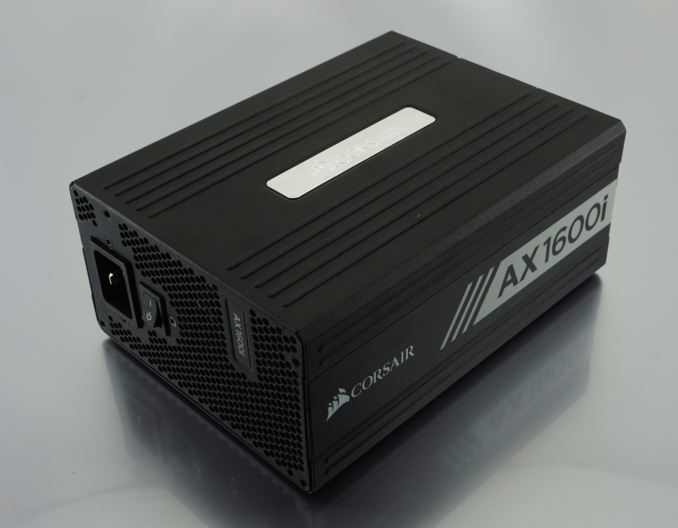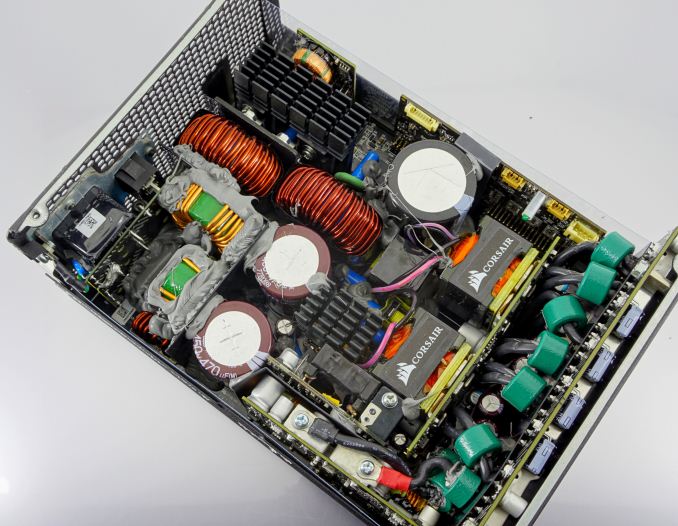The Emperor of Efficiency: Corsair's AX1600i PSU Rules Alone (Review)
by E. Fylladitakis on April 18, 2018 9:30 AM ESTConclusion
Corsair's intent behind the creation of the AX1600i was to create a product that is technologically and qualitatively superior than anything else in the consumer's market, with little regard for its production cost and, ultimately, the retail price. It is the kind of product aiming to please just a select few who want to build top-tier gaming systems or workstations regardless of the monetary cost.
Technologically, the AX1600i undoubtedly is the most advanced PSU that is currently available to consumers. The Gallium Nitride (GaN) parts are smaller, lighter, and significantly more efficient than their classic silicon-based counterparts. Their use allowed Flextronics (and ultimately Corsair) to design a platform that combines better overall performance and higher output into a smaller chassis. The end result is a PSU that is no larger than most 800W designs and yet is capable of delivering twice that power output without flinching. GaN parts are greatly more expensive than their silicon-based counterparts but the final product's cost was partially offset by the reduction in size and cooling requirements, allowing Corsair to maintain the price of the AX1600i at relatively reasonable levels.
The overall performance of the AX1600i is incomparable to that of classic PSU designs. Even the top tier models from other known manufacturers would have a hard time competing with the AX1600i on a single performance aspect - let alone every aspect. The power quality is textbook, with barely any voltage ripple appearing on any of the lines and under any load, while the voltage regulation is practically ideal. The very high electrical efficiency of the platform not only minimizes energy waste but also allows the PSU to operate very quietly and maintain low internal temperatures even when heavily loaded. Its very high quality parts are almost completely unaffected by environmental factors, ensuring that the AX1600i will perform 100% even in harsh environments. Taken altogether this means that the AX1600i has no peer; simpy put, its performance is unparalleled.
Corsair's flagship combines the best possible overall performance with exceptional quality parts, fashioning the best consumer PSU that money can buy. However, the AX1600i's true enemy is itself. With a price tag of $500 and a power output of 1600 Watts, the PSU is both preposterously expensive compared to regular designs and has a power output that will be vastly oversized for almost every kind of user. Only a system with a very powerful CPU and at least four top-tier graphics cards will be able to reasonably load an AX1600i, and these systems are quickly becoming a relic as NVIDIA scale back on SLI & CrossFire support. Instead we'd be looking at edge cases such as heavily overclocked systems with a smaller number of video cards, or someone who needs a lot of Titan Vs for productivity purposes.
Still, Corsair's move to GaN components signifies a very important milestone, as it is very likely that we will be seeing them implemented in less powerful units in the near future. They will be especially useful in SFX designs, as they will be able to deliver a high power output very efficiently, allowing the creation of quiet SFX units for living room gaming systems.












39 Comments
View All Comments
zodiacfml - Thursday, April 19, 2018 - link
I have two rated 2000W PSUs and one 1800W. I am not capable of measuring its efficiency but I once compared its power consumption to a 650W Bronze PSU with a 300 watt load. The consumption at the wall are similar. I've read some comments that they cannot keep up with 100% load but I don't have such requirements.This leads me to think that the Chinese branded 2000W PSU(~$130) has a 90% or higher efficiency at 50% load.
dgingeri - Wednesday, April 18, 2018 - link
Nice! It actually beats my HX750i at my idle load (~110W at 86% efficiency). I have been hard pressed to find a better PSU than my HX750i.Ninjawithagun - Thursday, May 10, 2018 - link
My 'old' AX1500i easily maintains 97% efficiency at 600W output. To add to that amazing efficiency, the PSU fan rarely ever turns on, which means silent gaming for my custom watercooled system ;-)AdrianB1 - Wednesday, April 18, 2018 - link
Give me one with 350-400W and the same shape of efficiency curve on the reduced power range; make it semi-modular because I don't need to remove the 24 pin ATX cord. It is perfect for a modern computer with a 95W TDP processor and a 150W TDP GPU.I have the Corsair PSU that has some of these specs, but not the efficiency: Corsair TX550M; semi-modular, fair output power, low efficiency especially at 100W when I watch Netflix.
Jon Tseng - Wednesday, April 18, 2018 - link
Agree it looks overspecced, but thinking about silver linings I guess if you ran one of these at reduced load to serve say an 800W system it would be significantly cooler/quieter than an 800W PSU running at full load?PeachNCream - Wednesday, April 18, 2018 - link
The sound measurements are in the review as is a statement that the fan doesn't even turn on at sub-600W loads in the cold test results. At 800W loads, it produces 35 (cold) to 41 (hot) decibels making it very likely to be much quieter than any 800W PSU running at full load.Stas - Thursday, April 19, 2018 - link
that's how you're supposed to spec out a PSUJohnUSA - Wednesday, April 18, 2018 - link
I read that an actual owner who liked this very expensive model but hated its poor and cheap cables, and many of these cables were also quite short.Shame on the manufacturer to have such bad shortcomings and put an exorbitant price on this model.
Hope they will fix these issues immediately.
nowwhatnapster - Friday, April 20, 2018 - link
I doubt it, they want to push those premium sleeved cables. It would be nice if they were individually sleeved, but then it would be a $600 psu and you might want different colored sleeving at that price. Makes sense to sell the premium cables separate.I agree the stock cables are very ridged due to the in line capacitors. I used them for a brief time. They get the job done and do not compromise on quality, but they sacrifice aesthetics and usability.
bug77 - Wednesday, April 18, 2018 - link
And here I was thinking efficiency means buying a power supply that fits one's needs. I.e. 600W is more than enough for anyone that doesn't overclock and uses multiple GPUs at the same time...